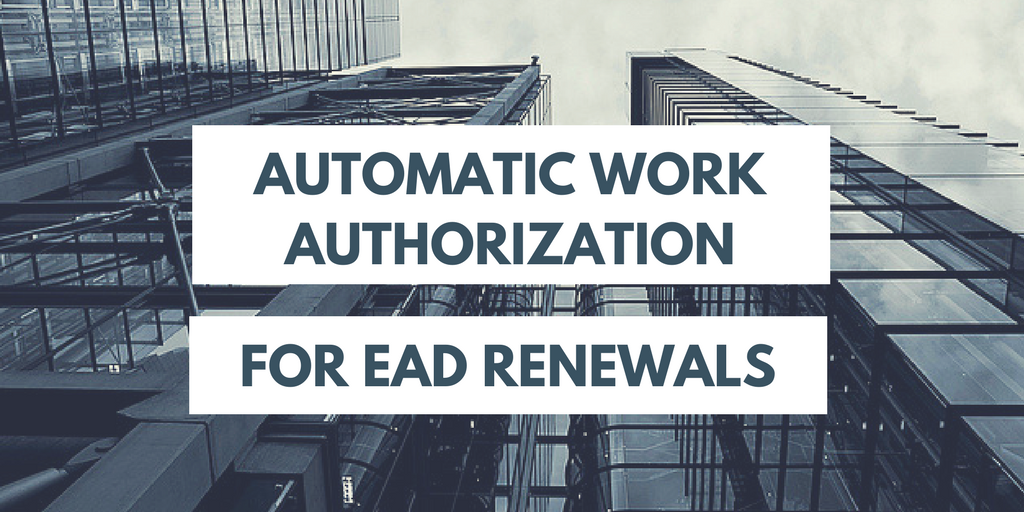USCIS Extends EAD Auto-Extension to 540 Days: What You Need to Know
USCIS has just released a new new temporary final rule (link to rule) effective as of April 8, 2024 pursuant to which the EAD auto-extension period is increased (again) from up to 180 days to up to 540 days from the expiration date stated on their EADs. This increase will be available to eligible renewal applicants with pending Forms I-765 as of April 8, 2024 based on EAD renewal applications filed on or after October 27, 2023 through September 30, 2025.
As a background, the default auto-extension period of 180 days was previously increased to 540 days until October 26, 2023. USCIS is now extending again this period to 540 days for another temporary period.
The New Rule Grants Automatic Employment Authorization Based on Timely-Filed EAD Extension
The new rule grants an automatic employment authorization for up to 540 days in cases where a timely-filed EAD renewal is pending. This rule has some specific caveats and restrictions – and not all types of EAD are covered by the rule.
Timely EAD Renewal Filing
The rule specifically states that the automatic employment authorization is granted only when the EAD renewal is filed timely which means that the EAD renewal is filed with USCIS prior to the expiration of the previous EAD card without any gap. There is no automatic work authorization grant if a renewal EAD is filed after the previous EAD has expired.
540-day Maximum
The automatic work authorization would last until the earlier of 540 days have passed from the expiration of the previous EAD card or the renewal EAD application is denied. It should be noted that if the government requests additional evidence (“RFE”) then the application is normally considered pending.
Only EAD Renewals Based on the Same EAD Category
The EAD renewal must be based on the same work authorization document category as the previous EAD.
Only Certain EAD Categories (Generally, Ones Which Do Not Require Adjudication of Underlying Status) Are Eligible
Possibly the most common category is (c)(9) which is EAD based on a pending I-485 Adjustment of Status application. The included EAD categories are: refugees – (a)(3), asylees – (a)(5), parents or dependent children of people who got permanent residency under INA 101(a)(27)(I) – (a)(7), citizens of Micronesia or the Marshall Islands – (a)(8), applicants granted withholding of deportation or removal – (a)(10), TPS (a)(12) and (c)(19), applicants with pending asylum or withholding of deportation or removal – (c)(8), pending adjustment of status applicants – (c)(9), applicants with pending suspension of deportation and cancellation of removal – (c)(10), applicants for creation of a record of lawful admission for permanent residence – (c)(16), legalization applicants – (c)(20) and (c)(22), LIFE Act adjustment applicants – (c)(24), VAWA cases – (c)(31). See also USCIS website.
Note that DACA and F-1 OPT-based EAD cards are not included in the 540-day automatic extension rule.
H-4, E and L-2 Dependent Spouses
Unfortunately, H-4/E/L-2 spouses may find it hard to take advantage of this auto extension rule. For H-4, E, and L-2 dependent spouses, an unexpired Form I-94 indicating H-4, E, or L-2 nonimmigrant status (including E-1S, E-2S, E-3S, and L-2S class of admission codes) must accompany Form I-797C when presenting proof of employment authorization to an employer for Form I-9, Employment Eligibility Verification, purposes). Basically, the H-4 status must already be extended (by getting H-4 extension approval or entering the US) in order for the H-4 EAD I-765 to be eligible for auto-extension.
As a result, the auto extension would not apply in cases where the H-4 spouse has filed a concurrent H-4 status and H-4 EAD extension. This makes it very important to plan carefully for H-1B, H-4 and H-4 EAD extensions as there may be options for taking advantage of the auto-extension rule for H-4 spouses.
540-day Auto Extension Period Until September 30, 2025
The 540-day EAD auto extension temporary final rule is valid for I-765 pending as of April 8, 2024 (even if the prior 180-day auto extension term has ended) and for new I-765s filed before September 30, 2025.
Conclusion
We welcome DHS’s publication of the temporary final rule and the grant of employment authorization based on pending EAD renewals for certain applicants. Earlier EAD renewal filing is also very helpful. Please do not hesitate to contact us if we can review your case, answer any questions or schedule a consultation. We also invite you to subscribe to our free weekly immigration newsletter to receive timely updates on this and related topics.
Related News and Articles
The Capitol Immigration Law Group has been serving the business community for over 15 years and is one of the most widely respected immigration law firms focused solely on U.S. employment-based immigration. Disclaimer: we make all efforts to provide timely and accurate information; however, the information in this article may become outdated or may not be applicable to a specific set of facts. It is not to be construed as legal advice.

